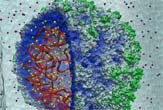
This is no ordinary computer virus. Using a real-life virus as a model, researchers have built a virtual version using more than a million digital atoms.
Scientists have previously simulated small pieces of living cells, but researchers say this is the first digital simulation of an entire life form.
The achievement could lead to a better understanding of the inner workings of viruses and improvements in human health, the researchers say. It could also be used to help build nanomachines surrounded by shells similar to the protein capsid shell that protects viruses and helps them determine when to latch onto potential host cells.
Life or not?
Viruses are tiny bundles of protein and genetic material that straddle the line between life and non-life. Many scientists prefer to call them "particles" because even though they contain RNA or DNA like other lifeforms, they can only replicate inside other living cells. Viruses have evolved elaborate ways to infect cells and proliferate inside their hosts and are the cause of myriad diseases, such as flu and HIV.
For their project, the researchers chose to digitally reverse engineer the satellite tobacco mosaic virus due to its small size and simplicity.
In fact, the satellite virus is so simple that it can only infect a cell that has already been hijacked by another virus, the tobacco mosaic virus that infects a variety of plants.
Sign up for the Live Science daily newsletter now
Get the world’s most fascinating discoveries delivered straight to your inbox.
Brief existence
The researchers used one of the world's largest and fastest computers to simulate all the atoms in a satellite virus and a small drop of water surrounding it. All together, the virus and water droplet contained more than a million atoms. Because of the enormous computing power involved, the virus was brought to digital life for a very brief period of time, only 50 nanoseconds.
The achievement is a big first step in "test flying" living organisms, said study team member Klaus Schulten, a physicist at the University of Illinois at Urbana-Champaign, but it could still be a long time before scientists can simulate a digital dog wagging its tail.
The simulation, created by researchers at Illinois and the University of California, Irvine, is detailed in the March issue of the journal Structure.









